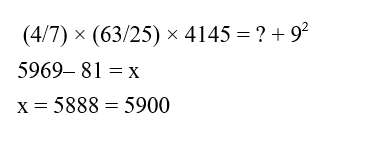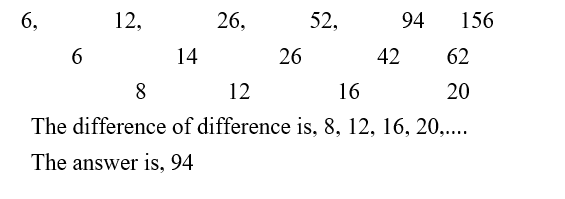Question 1: 
Question 2:
Direction: What approximate value should come in the place of question mark (?) in the following questions?
निर्देश: निम्नलिखित प्रश्नों में प्रश्नवाचक चिह्न (?) के स्थान पर लगभग मान क्या होना चाहिए?
(7/19) of 8740 + (6/25) of 7175 =? × 7
Question 3:
Direction: What approximate value should come in the place of question mark (?) in the following questions?
निर्देश: निम्नलिखित प्रश्नों में प्रश्नवाचक चिह्न (?) के स्थान पर लगभग मान क्या होना चाहिए?
19 × 1152 ÷ 12 % of 1199 = 75 + ?
Question 4:
Direction: What approximate value should come in the place of question mark (?) in the following questions?
निर्देश: निम्नलिखित प्रश्नों में प्रश्नवाचक चिह्न (?) के स्थान पर लगभग मान क्या होना चाहिए?
12 = 25 × 279.89 ÷ 7.21 + ? – 4899
Question 5: 
Question 6:
Directions: What value should come in the place of question mark (?) in the following number series?
निर्देश: निम्नलिखित संख्या श्रेणी में प्रश्नवाचक चिह्न (?) के स्थान पर क्या मान होना चाहिए?
6, 12, 26, 52, ? , 156
Question 7:
Directions: What value should come in the place of question mark (?) in the following number series?
निर्देश: निम्नलिखित संख्या श्रेणी में प्रश्नवाचक चिह्न (?) के स्थान पर क्या मान होना चाहिए?
35, 38, 50, ? , 125, 200
Question 8:
Directions: What value should come in the place of question mark (?) in the following number series?
निर्देश: निम्नलिखित संख्या श्रेणी में प्रश्नवाचक चिह्न (?) के स्थान पर क्या मान होना चाहिए?
156, 78, 117, 292.5, ? , 4606.875
Question 9:
Directions: What value should come in the place of question mark (?) in the following number series?
निर्देश: निम्नलिखित संख्या श्रेणी में प्रश्नवाचक चिह्न (?) के स्थान पर क्या मान होना चाहिए?
17, 25, 77, 295, 1305, ?
Question 10:
Directions: What value should come in the place of question mark (?) in the following number series?
निर्देश: निम्नलिखित संख्या श्रेणी में प्रश्नवाचक चिह्न (?) के स्थान पर क्या मान होना चाहिए?
11, 2, 20, 35, 176, ? , 5050





